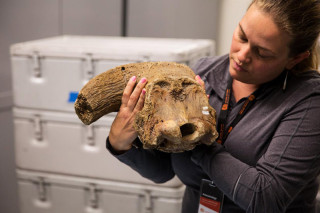Explorer Corps Marker: Salt Lake County
Find the Marker
The Salt Lake County marker is located in a grassy area just outside the main entrance to the Natural History Museum of Utah (NHMU). The Museum is located at 301 Wakara Way in Salt Lake City. The marker highlights Baskin's Musk Ox Skull, a fossil of the extinct species Bootherium bombifrons.
GPS 40°45’50.6”N 111°49’24.0”W
Dig Deeper
More than 10,000 years ago, musk oxen roamed what’s now Salt Lake City. That might seem a little odd, especially given that these shaggy mammals are found in the Arctic tundra today. But the Salt Lake Valley of the Ice Age was a very different place than that of today, and one of the first fossils found in the Salt Lake City area helps highlight just how much the world has changed since the waning days of the Pleistocene.
In 1871, workers were digging a cellar for former Salt Lake City mayor and later Utah Supreme Court justice Robert N. Baskin in the vicinity of today’s Temple Square. In the process, they dug down into gravel that was laid down during the Ice Age, and about six feet down they found the skull of a horned mammal.

At first, the skull seemed familiar. The May 17th morning edition of Salt Lake Daily Tribune & Utah Mining Gazette announced the find as a “petrified buffalo head,” or the skull of a bison. It wasn’t until the find was examined by scientist P.A. Chabourne, however, that the fossil’s real identity started to come into focus. This wasn’t a bison, but a musk ox that had roamed the Salt Lake area back when much of the valley was filled by the great Lake Bonneville. In time, the skull was recognized as Bootherium bombifrons, an extinct species of musk ox.
The fossil now rests at the Natural History Museum of Utah, where it was transferred in 1978. And even though other Ice Age fossils have been found in the area of Salt Lake City since 1871, the skull still holds a special place in the Museum’s collection. “It’s scientifically and historically very important because it was the first fossil evidence that Utah’s past climate, before 10,000 years ago, was much colder and supported animals that today only live in the Arctic regions,” says Dr. Randall Irmis, NHMU's chief curator and curator of paleontology.
But the importance of the musk ox skull isn’t just in terms of a chillier time when musk oxen and mammoths roamed northern Utah. Fossils in museum collections are important for making comparisons between specimens and understanding how these animals actually lived. “For the longest time,” Irmis says, “paleontologists thought there were two different species of musk ox in the Late Pleistocene of North America” – Symbos cavifrons and Bootherium bombifrons. The skull found in Salt Lake City was thought to be an example of Symbos. But in the late 1980s, Irmis notes, paleontologists Jerry McDonald and Clayton Ray realized that these two species were actually the males and females of the same species, and so combined Symbos and Bootherium into a single species (using the name Bootherium, which was the older name). The skull found in Salt Lake City was from a male.
The historic fossil is now just one part of the city’s Ice Age record. “Several hundred Ice Age mammal fossils have been found throughout the Salt Lake metro area,” Irmis notes, including another Bootherium skeleton uncovered at the Huntsman Corporation building on the University of Utah campus. As construction crews continue to dig down, who knows what other Ice Age fossils they might find?
Want to Go Farther?
The Baskin's Musk Ox fossil in the collections of the Natural History Museum of Utah is notable because it was the first example of Ice Age fauna from Utah, and because of where it was discovered. The site it was found at is in downtown Salt Lake City, close to the intersection of North Temple and State Street, less than five miles to the west of NHMU. Although the Baskin's Musk Ox fossil is not on display, there is a musk ox fossil shown in NHMU's Past Worlds gallery.